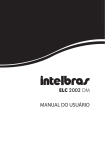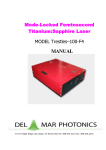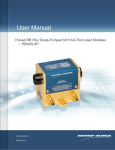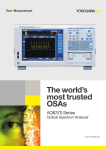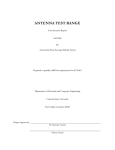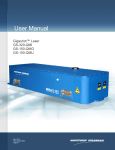Download TOPAS 4/800 MAINTENANCE GUIDE
Transcript
TOPAS-800 The Optical Parametric Amplifier User’s Manual © Light Conversion Saulėtekio av. 10 LT-10223 Vilnius, Lithuania Email: [email protected] Web: http://www.lightcon.com Light Conversion TOPAS-800 User’s Manual CONTENT PREFACE ............................................................................................................................................3 IMPORTANT NOTES ......................................................................................................................4 SAFETY ...............................................................................................................................................4 CRYSTAL HANDLING ....................................................................................................................4 1. REQUIREMENTS FOR PUMP LASER .....................................................................................5 2. DAYLY OPERATION ..................................................................................................................6 3. TOPAS DESCRIPTION..............................................................................................................7 3.1 Principles of TOPAS design ............................................................................... 7 3.2 First, second and third passes: formation of the seed.................................. 9 3.3 Fourth pass: pre-amplification of the seed beam. ....................................... 10 3.4 Fifth pass: final amplification. ......................................................................... 13 4. TOPAS DIAGNOSTICS, REALIGNMENT AND CALIBRATION ....................................15 4.1. Diagnostics: pump beam and pulse parameters .......................................... 15 4.2. Diagnostics: TOPAS optical elements ............................................................ 15 4.3. Diagnostics: TOPAS alignment........................................................................ 16 4.4. Realignment: First, Second and Third passes: seed signal ........................ 18 4.5. Realignment: Fourth pass: pre-amplification of the seed. ......................... 19 4.7. TOPAS recalibration .......................................................................................... 25 APPENDIX I: TOPAS Layout.....................................................................................................26 APPENDIX II: Additional procedures ...................................................................................27 APPENDIX III: Photos ...............................................................................................................29 ABBREVIATION SIGNIFICATIONS ...................................................................... 34 Light Conversion 2 TOPAS-800 User’s Manual PREFACE This guide is aimed to provide the user with alignment instructions specific for TOPAS4/800 (5-pass TOPAS version pumped by the fundamental radiation of a pico/femto Ti:Sapphire laser). It assumes that a service engineer approved by the manufacturer has installed the TOPAS. It also assumes that the user knows the basics of optical parametric amplification and has medium to high level of experience in the field of experimental ultrashort-pulse laser optics. Part 1 of this guide gives the main procedures required for usual day-by-day operation of the TOPAS. Part 2 describes the TOPAS setup and gives a detailed picture of how the TOPAS alignment should look-like in order for the device to function properly. Part 3 covers TOPAS diagnostics, realignment and recalibration procedures in case Part 1 procedures cannot restore the specified or usual TOPAS output. Please, read Part 2 before proceeding with Part 3. Note 1: If you are in doubt of any action or procedure described here, please contact our service team for more advice before acting on TOPAS. Note 2: The user is responsible for any damaged to TOPAS optics or/and mechanics, which occurred during the TOPAS alignment by the user. We would like to thank our TOPAS user Daniel-Steve Fournier from University of Toronto, who compiled “TOPAS FINE ALIGNMENT PROCEDURE”, which was used as a basis of this guide. Light Conversion 3 TOPAS-800 User’s Manual IMPORTANT NOTES Read this Guide section first. It contains, in brief, the information that you should remember when operating TOPAS. SAFETY TOPAS is a Class IV laser product. The used and emitted power/ pulse energy may vary upon the type of pump laser used. At kilohertz repetition rate, the average input power may exceed 1 W, with pulse duration ranging from 20 fs to 30 ps. In low repetition rate mode (1-10 Hz), TOPAS can accept up to tens of milijoules of pump energy. Be very careful when aligning TOPAS. Warning! Avoid viewing beams and specular reflections. Use protective eyewear at all times when aligning and operating TOPAS. Make sure that your protective glasses cover the tuning range of TOPAS! Remember that parametric radiation can be beyond the range of human vision. CRYSTAL HANDLING Nonlinear crystals used in TOPAS for generation of IR tunable pulses as well as crystals for second harmonics or sum frequency generation are fabricated of beta-barium borate (BBO) or lithium triborate (LBO). These crystals are known to be hygroscopic. Crystals used in TOPAS have protective coatings, but they do not ensure absolute protection. Heater in TOPAS provides extra protection against moisture. It must be kept switched-on when the crystal is installed. If you do not intend to operate TOPAS for longer period, you can remove the crystal together with the mount and pack it in sealed container with desiccant. When cleaning the faces of crystal use acetone (methanol, ethyl acetate) of >99.5% purity. Warning!. Never touch the crystal with bare hands. Crystals used for difference frequency generation are not hygroscopic. Instead, GaSe crystal is very soft. The surfaces can be scratched easily and the crystal bends if even small force is applied. Light Conversion 4 TOPAS-800 User’s Manual 1. REQUIREMENTS FOR PUMP LASER Good performance of TOPAS requires high pump quality in terms of both time and space coherence. This means that ideal pump is diffraction-limited beam and transform limited, high contrast pulses. Unlike with conventional lasers with coherent pump, the phase modulation of pump pulse and/or beam inevitably influences the output. To some extent, performance of TOPAS is an indicator of quality of the pump laser radiation. In femtosecond systems that use nowadays-standard chirped pulse amplification technique (CPA), there are specific possible causes of distorted beam or pulse. Some of them are discussed below. Spatial beam quality. Non-uniformity of the beam reduces the energy conversion rate. Presence of hot spots in the beam may “ignite” small-scale self-focusing that in turn leads to phase modulation. In the power amplifiers, hot spots also can produce parametric superfluorescence what prevents of rising average power in order to achieve high conversion in to parametric radiation. Presence of supercontinuum with low parametric conversion may indicate that pulse profile is not uniform Spatial/temporal beam distortion. In contrast to long pulse lasers, astigmatism introduced by improperly aligned lenses of beam expanders/reducers lead to distortion of temporal profile of the pulse across the beam as well. This makes it impossible to overlap pump and signal pulses over entire beam aperture. Tilted pulses. This phenomenon manifests itself in similar way as that discussed above, however, it originates from improper pulse compressor alignment. Tilted pulses are produced when the angular dispersion is not completely cancelled. The problem with this kind of distortion is that it can be easily overlooked using standard diagnostics equipment such as autocorrelator. Underseeded regenerative amplifiers. The seed pulses for regenerative amplifier can be too week due to low oscillator power, poor mode matching or improper Pockels cell timing. This results in rather high energy content in the background. Background can be detectable neither by oscilloscope nor by autocorrelator. Simple test for background is measurement of build-up time of unseeded and seeded regenerative amplifier. In last case the build-up time should be shorter at least by 15-20%. Feedback to master oscillator. With oscillators that use regenerative acousto-optic mode locking, reflections coming from TOPAS may cause interference. There are several methods to avoid this. When aligning TOPAS, take care, that any reflections from the optical elements are not directed backward along the pump channel. Another one is to switch off the modelocker when oscillator is running in self-mode locked regime (this option can be used only in femtosecond systems). The most recommended is to install an additional Faraday isolator between master oscillator and pulse stretcher. Light Conversion 5 TOPAS-800 User’s Manual 2. DAYLY OPERATION Below you will find description of the procedures that you should perform when starting TOPAS operation. 1. Warm-up the TOPAS pump laser and perform day-by-day checking/adjustment procedures recommended by the laser manufacturer. Verify the TOPAS pump energy is set to the specified/ usual value. 2. Start the TOPAS software WINTOPAS and tune the TOPAS to a checkpoint wavelength(s). Verify the TOPAS output energy at that (those) wavelength(s) is corresponding to the specified/ usual value. 3. If the TOPAS output energy at checkpoint wavelength(s) is lower the specified/ usual values, check the Signal+Idler (S+I) energy with no mixing crystals involved is corresponding to the specified/ usual values. 4. If S+I output is OK, reset a Mixer(s), which produced lower output. Measure a new Mixer offset if needed. 5. If S+I output is low, try to restore the output energy by fine adjustment of the pump beam steering mirror closest to the TOPAS input. Warning! Be careful when aligning pump input direction. Any pump beam should fit the aperture of nonlinear crystal. If pump hits the holder of crystal a deposition of metal particles on the crystal surface eventually will cause the damage of crystal. 6. If S+I output is low after the fine adjustment of the input mirror, reset the TOPAS motors. 7. If all above does not help to get specified/ usual TOPAS output, proceed to the TOPAS diagnostics and realignment section (Part III), which will help you to detect and fix the problem. Part II is recommended to read before starting with part III. Light Conversion 6 TOPAS-800 User’s Manual 3. TOPAS DESCRIPTION In this chapter we present the general principles of TOPAS design and will try to give a detailed feeling to the reader about what is going on at each stage of parametric amplification in TOPAS. An alignment procedure will follow at the next part of manual. 3.1 Principles of TOPAS design TOPAS configuration. TOPAS employs one stage of generator of superfluorescence (SFL) and four light amplification amplifier stages arranged in a single BBO. Generator of SFL (first pass through the nonlinear crystal) serves as a seeder emitting broad-banded superfluorescence. Preamplifiers (second and fourth passes through the nonlinear crystal) shape the beam acting as a small amplifying aperture placed in the far field of the seeder. In third pass through nonlinear crystal the amplification usually is negligible. The last amplification stage (fifth pass through nonlinear crystal), which usually is pumped by the bulk of the available pump, boosts the energy of the parametric pulse. With pump beam of high spatial coherence and carefully adjusted pump beam size in the preamplification stages, TOPAS emits beam with divergence close to the diffraction limit. TOPAS configuration has the advantage that dielectric mirrors of relatively narrowbandwidth and low dispersion are used to direct the pump beams. In the beam path of signal pulse the metal-coated mirrors are used. In this way, full tuning range can be covered without replacing the optics. Wavelength tuning. Wavelength tuning in TOPAS is performed by nonlinear crystal rotation in phase matching plane. The changing of crystal angles raises the problems related to beam/ pulse displacement. In TOPAS these problems are solved in part by using quartz compensation plate that is being tilted along with the crystal, in part by time delay units that are controlled by stepper motor. Nonlinear crystals. BBO with pump wavelength ranging from near UV to near IR is operated in type II phase matching configuration. The maximum available signal wave frequency can be defined as s = p - abs ,where s is the maximum signal frequency, p is pump frequency and abs is the IR absorption edge that equals approximately to 3300 cm-1.The type II phase matching has a serious advantage of comparatively narrow gain bandwidth and allows for generation of <1 ps pulses with time/bandwidth product well below unity. The bandwidth does not increase at the degeneracy what is the case for type I phase matching since full degeneracy does not exist. For type II phase matching the polarization of signal and idler waves are orthogonal even if frequencies are equal. This also gives a possibility to separate signal and idler waves using polarizer. Grating frequency selection. In order to reduce the spectral width and to stabilize its shape a diffraction grating is installed between preamplification stages. When tuning TOPAS the change of grating angles is controlled by the stepper motor that is synchronized with the nonlinear crystal rotation. When TOPAS is pumped by femtosecond pulses the spectrum of parametric pulses is formed by nonlinear process amplification itself. Nevertheless, the employment of grating makes the operation of TOPAS more reliable and simplifies the procedures of femtosecond TOPAS calibration. Crystal protection and control electronics. In order to protect nonlinear crystals against atmosphere humidity the AR/protective coatings optimized for pump wavelength are used in combination with permanent crystal heating. Temperature controller keeps the crystal temperature at about 40o C. The temperature controller is assembled on a board that interfaces the stepper motors with IBM compatible PC via parallel printer adapter. One board can control up to 6 stepper motors, four boards can work in parallel. Light Conversion 7 TOPAS-800 User’s Manual Pump Laser Options: Power Levels, Wavelengths, Pulsewidths. TOPAS can be pumped with the different kind of lasers whose wavelength can range from UV up to near infrared. Obviously, short wavelength pump appears to be more attractive since larger wavelength range can be covered in a basic TOPAS unit. However, with femtosecond pulses group velocity mismatch becomes relevant. It increases with shorter pump wavelength thus limiting application of UV pump sources. So far, the operation of TOPAS has been tested when pumped with 0.2 - 30 ps pulses of SH of Nd laser, 7 - 30 ps pulses of TH of Nd:YAG laser, 0.02 - 2 ps Ti:sapphire laser fundamental pulses, 0.5 - 2 ps pulses of SH of Ti:saphire laser, femtosecond dye laser pulses of 0.6 m. In all the cases energy conversion into parametric radiation of ~20% and more were achieved. An important feature of TOPAS design is that it can be matched to pump sources with peak power ranging over orders of magnitude. The minimum 150 fs pump pulse energy ensuring > 10% parametric conversion is around 100 J. No limitations for pulse repetition rate up to 10 kHz were observed. Additional options for frequency conversion. In the same way as output of a conventional laser the output of TOPAS can be frequency doubled and quadrupled. Moreover, the presence of three wavelengths at the output offers extra possibilities. First, both signal and idler waves or their harmonics can be mixed with the rest of the pump for sum frequency generation thus shifting the tunable radiation towards blue. Therefore, using optional nonlinear frequency converters one can obtain the tunable radiation down to ~ 190 nm. Second, difference frequency can be produced mixing signal and idler waves. This process transfers the wavelength of tunable radiation to mid-IR covering 2.4 –20 m wavelength range. We should note, that in case of Ti:sapphire laser, the use of difference frequency generation from TOPAS output allows one to overcome the problem of one and/or two photon absorption of the IR transparent crystals. Light Conversion 8 TOPAS-800 User’s Manual 3.2 First, second and third passes: formation of the seed The first three passes in TOPAS are used for the generation and pre-amplification of the stable seed pulse for subsequent amplification stages. In Figure 1. you can see the schematics of the first three passes through nonlinear crystal in TOPAS. TOP VIEW M1 CL1 A2 3rd part of the pump beam L1 BS2 BS1 A1 PUMP MAIN ASSEMBLY 2nd part of the pump beam 1st part of the pump beam L2 CM2 NC M7 CL2 DG M5 M2 CM1 CM2 M7 SIDE VIEW M2 NC M5 CL2 DG CM1 Figure 1. The first, second and third beam pass inside the TOPAS. The incoming pump beam is split into three components by means of beam splitters (BS1 and BS2) upon entering the TOPAS. The first two are going to be used for the fourth and fifth passes (seed amplification). The third component is the light that passes through BS1 and BS2 to be reflected by the mirrors M1 and M2 in the main assembly towards the nonlinear crystal (NC) and is referred as the first pump that generates parametric superfluorescence (SFL) signal (a seed ) inside the TOPAS. This latter component of the light will do in total three passes in the NC, which they will be called respectively the first, second and third passes. 1-3rd passes use both spherical (L1, L2) and cylindrical (CL1, CL2, CM1, CM2) optics to shape the beam, thus it is normal that the beams have no spherical symmetry in the 1-3rd passes. The first pass goes from the lower edge of M2 to the upper part of CM1. That first pump pulse through the NC is used for producing of SFL. The optimum pump intensity for producing of SFL is set at the installation adjusting aperture A size and cylindrical telescope consisting of lenses L1, L2 and CL1. (Typical shape of pump beam with SFL, seen as sum-frequencies: pump plus signal, pump plus idler, SH of signal and so on, is presented in Photo 1). The second pass is the backward reflection from CM1, through the NC, to CM2. This second pass amplifies the collinear components of SFL produced in the first pass. TOPAS pumped by ~800nm light generates IR wavelengths (~1.1-1.6 m for signal and ~1.6-2.6 m for idler waves), which is not visible to human eye. However some IR wavelengths get mixed with the pump in the same NC and produce week visible output. Thus one can see a visible beam (e.g. green when signal is set to ~ 1500 nm or reddish when signal is set to ~ 1200 nm) overlapped with the pump Light Conversion 9 TOPAS-800 User’s Manual starting from the second pass (SFL after the first pass is usually to week to be seen). The visible light follows approximately the same path as the true signal and idler beams and can be used as guidance in TOPAS alignment and as an indication of parametric conversion. You can see the pattern of light corresponding to amplified SFL placing the card behind the main assembly in front of CM2 (Photo 2). NOTE! You should distinguish the visible light caused by parametric light generation from the light that appears due to the supercontinuum generation. Supercontinuum generation starts at the pump intensities slightly higher as compared to the threshold for SFL and emerges as a white light or colored center-symmetric rings at the output of crystal. (Photo 3). Warning! Remember that thresholds of supercontinuum generation and optical damage of crystal are rather close. Don’t work in condition of supercontinuum generation for a long time. The third pass is the reflection from CM2 through the NC to the diffraction grating (DG). In the third pass the beam of amplified SFL goes just above CM1 and hits the center of DG. The beams of first three passes do not overlap in space but are in the same vertical plane. Notice that the beams after third pass through NC goes through the assembly of slit and cylindrical lens CL2. The slit transmits only central portion of beam serving in this way as a cursor for the proper alignment of TOPAS. Then the beam collimated by CL2 hits the center (axis of rotation) of the DG. You can see pattern of preamplified parametric light placing the card behind and in front of slit and CL2 assembly. (Photo 4 and Photo 5 correspondingly). 3.3 Fourth pass: pre-amplification of the seed beam. The fourth pass in TOPAS is employed for the formation of stable, nearly transform-limited and low diffraction seed for the power amplifier of TOPAS. After three passes we basically have a relatively weak, broad-banded parametric radiation with significant divergence in vertical plane. The amplification in the fourth pass through the nonlinear crystal shape the parametric signal acting as a small amplifying aperture placed in the far field of the seeder. The schematic of the seed pulse pre-amplification in the fourth pass is presented in Figure 2. Amplified parametric signal Pump beam M5 CL2 DG NC Light Conversion 10 TOPAS-800 User’s Manual Figure 2. Scheme showing the principle of the pre-amplification in the fourth pass. The seed beam is spread in spectrum in plane of NC by means of DG and CL2. The fresh portion of pump is delivered to NC at the fourth pass using a thin mirror M5. TOPAS is aligned in the way that the parametric signal pulse is overlapped both in space and in time with pump pulse. Since pump beam waist on the crystal is significantly reduced by telescope, only a part of spectrum of the diffracted seed beam will be amplified. As the result, the amplified parametric radiation has a diffraction that is close that of the pump beam. Notice that grating employment serves for several purposes: i) to narrow the amplified signal spectrum; ii) to separate signal, idler and pump in space; and iii) to make wavelength tuning more precise in the wavelength range close to NC absorption band. The grating rotation stage is driven by a stepper motor. When tuning TOPAS the appropriate grating angle is set by TOPAS control software. The diffraction grating is operated in autocollimation mode. It should be noted that due to limited range of rotation stage the different grating diffraction orders are used in order to cover all tuning range. In picosecond operation mode the diffraction grating is operated at high diffraction orders for a maximum spectral resolution and high diffraction efficiency. Incidence angle usually is in between 70 and 40 deg. In femtosecond mode the grating is operated at incident angles between 10 and 30 deg. At these angles grating dispersion is low and diffraction efficiency is high enough. The arrangement of beams in fourth pass through the nonlinear crystal is presented in Figure 3. TOP VIEW CL1 M1 M4 L4 A2 L1 BS2 BS1 A1 PUMP L3 M3'' GP L2 M7 NC M5 CL2 DG M2 for monitoring of preamplifier operation A3 L3' M3 SIDE VIEW M7 M4 M3' M2 L4 L3 M3'' L5 M5 CL2 DG NC Figure 3. The fourth beam pass inside the TOPAS. The beam reflected from BS2 is used as a pump for signal amplification in the fourth pass through NC. It passes the zoom telescope, consisting of lenses L3’, L3 and L4, and after reflection Light Conversion 11 TOPAS-800 User’s Manual from M4 and M5 enters the NC. After the telescope the pump beam focuses and, usually, has the beam waist at the plane of NC. The beam wais radius is optimized for the maximum signal amplification rate: the pump intensity should be just below the threshold of parametric superfluorescence and/or continuum generation. Before entering the NC the pump beam then passes a fused silica plate (GP) that compensates for the lateral displacement of beams in the first three passes introduced when crystal changes its angle. This ensures that the pump beam hits the mirror M5 always at the same spot as the seed beam. Then, M5 reflects the pump towards the NC. The seed pulse (signal) reflected from the DG passes M5 to meet the pump pulse at the reflecting surface of M5. The DG is mounted on a delay stage and one could adjust the temporal delay between the seed and pump pulses for their overlapping in time. This is the DELAY 1 adjustment. The optimum delay is set during installation of TOPAS and could be needed for adjustment only when the 4th pass alignment is changed. In NC only almost collinear spectral components of the seed diffracted by DG are amplified due to small pump beam size. When tuning TOPAS the DG is rotated in accordance with changes of NC crystal angle. In this way the spatial overlap of appropriate spectral components with pump beam is ensured in all tuning range. Then, the pre-amplified seed beam goes through M2 (dielectric mirror M2 is of high reflectivity only for ~ 800 nm radiation at 45 incidence). The concave Al mirror M7 directs backwards the amplified seed beam slightly above the NC. You can monitor the preamplifier operation placing a paper sheet at the side edge of main assembly (see “for monitoring of preamplifier operation” in Figure 3.). Two bright visible spots (partial beam reflection from the substrate of M2) can be seen on the paper sheet. The intensity of spots should significantly change if either of pump or seed (1-3rd passes) is blocked. Light Conversion 12 TOPAS-800 User’s Manual 3.4 Fifth pass: final amplification. At this point, we have a seed beam that has been pre-amplified in the fourth pass through NC. This seed radiation is coherent to the great extent both in space and time and will be amplified to its final power level in the 5th pass by using the bulk of the incoming pump beam. In order to have high energy conversion efficiency at the last pass through the NC the seed and fresh pump beams are matched in size. Obviously, the seed and pump pulses should overlap both in time and space. The schematics of the final amplification stage are presented in Figure 4. TOP VIEW M1 A2 CL1 L1 L4 M4 BS2 BS1 L3 A1 M3'' L2 M12 PR CM2 DG M7 M11 CL2 M5 CM1 TD M8 M2 L6 L5 M10 M3 M3' A3 L3' M9 M9'' M9' SIDE VIEW M2 TD M12 M11 PR M8 DG CL2 Figure 4. The fifth beam pass inside the TOPAS. The seed beam reflected from M7 comes above the NC and passes the time delay crystal TD crystal that separates of signal and idler pulses in time. A bright visible spot is seen in front of TD as an indication of effective seed preamplifiction in the 4th pass (Photo 6). The spot should disappear if either of 4th pass pump or seed (1-3rd passes) is blocked (Photo 7 and Photo 8). The mirrors M7 and M8 form a telescope that expands and collimates the seed beam. M8 directs the seed beam to NC for final amplification. Light Conversion 13 TOPAS-800 User’s Manual The main part of pump reflected by BS1 is transported to the NC by series of high reflecting mirrors (M9, M9’, M9”, M10, M11). The mirror M10 is installed on the computer controlled mechanical delay line (DELAY 2) giving the possibility to perform fine time delay adjustment when tuning TOPAS. The telescope consisting of lenses L5 and L6 allows for setting of optimum pump intensity on the nonlinear crystal: the pump intensity should be high enough to saturate amplification, but at the same time should be below the threshold of SFL and supercontinuum generation. TOPAS is aligned in the way that the 5th pass pump beam overlaps the parametric signal at M11, in nonlinear crystal and in the far field at the output of TOPAS. In other words the collinear amplification configuration is used in TOPAS. Notice, that 5th pas beam lays in same or parallel plane with reference to plane containing beams of the 1st - 4th passes. In the final amplification stage the parametric pulses are amplified from the level of several microjoules to the specified output energy and transmitting the mirror M12, that blocks the pump, come to the output of TOPAS. In particular TOPAS model, on customer request, the polarization rotator (Berek compensator) is installed at the output of TOPAS. This unit enables the user to set the vertical polarization for both signal and idler pulses. Once installed the TOPAS, usually, need no adjustment of its element angles or positions. When tuning the crystal and grating rotation stages as well as delay line are moved by stepper motors controlled from computer. TOPAS software drives the stepper motors with reference to data of written to tuning curve file. The tuning range of TOPAS output can be significantly broadened by means of optional frequency converters (harmonic generators, sum and difference frequency generators) enabling the user to cover the wavelength range from deep UV to mid-IR. If the pump characteristics correspond to the specified one, the fail of TOPAS normal operation could be caused by several reasons: The input pump beam direction is changed The calibration of stepper motor(s) is lost There is an optical damage of certain optical element In the following chapters you will be presented with detailed instruction for TOPAS diagnostics and alignment procedures that will help you to restore the specified TOPAS operation. Light Conversion 14 TOPAS-800 User’s Manual 4. TOPAS DIAGNOSTICS, REALIGNMENT AND RECALIBRATION The femto/pico second pulses of several different wavelengths can be used as a pump for different TOPAS models. The basic principles of TOPAS diagnostics and alignments are the same, however the appearance of beam colors differs. When fundamental of Ti: sapphire laser is used as a pump its radiation is almost under the range of human vision, the parametric radiation is in infrared. Therefore, use a visible light that appears due to non-synchronous generation second harmonic and sum frequency in nonlinear crystal as a guide for axial components of superfluorescence, amplified parametric radiation. The pump beam direction can be traced observing the signal of non-phase-matched second harmonic of the pump (blue light spots). The dielectric mirrors are well transparent for a light in visible. When TOPAS is pumped by SH of neodymium lasers or SH of Ti:sapphire lasers, pump beam is well visible along all the beam path in TOPAS. In order to visualize the beam path of parametric radiation in case of pump by SH of Nd lasers it is advisable to perform diagnostics and alignment procedures when TOPAS is tuned for generation at wavelengths 650 -700 nm. If SH of Ti:sapphire is used as a pump tune TOPAS to 530 -570 nm wavelength range. When TOPAS is pumped by third harmonic of neodymium lasers, pump beam could be monitored using fluorescence of white paper illuminated by UV pump radiation. The signal parametric radiation is visible in all tuning range. The following subchapters presents the diagnostics and alignments procedure for TOPAS models pumped by fundamental of Ti:sapfire lasers ( ~ 800 nm). NOTE! THE PROCEDURE OF TOPAS DIAGNOSTICS AND REALIGNMENT CONTAINS TWO MAJOR STEPS. THE FIRST STEP IS A VERIFICATION PROCEDURE (Chapters 4.1-4.3). NO OPTICAL ELEMENTS SHOULD BE TOUCHED. THIS IS ONLY A DIAGNOSTIC PROCEDURE. SOME EXTERNAL MIRRORS MAY BE TWEAKED, BUT NOTHING INSIDE THE TOPAS SHOULD BE TOUCHED. 4.1. Diagnostics: pump beam and pulse parameters If possible, check the contrast ratio of the pump pulse, Check the pump laser performance and the TOPAS pump beam parameters such as energy, pulse duration, beam quality to correspond the specified values. The laser power should be approx. ________ W, pulse at _____Hz, _____fs duration, beam profile ___________________________. using a fast photodiode. The contrast ratio should be > 1/100 (or 100, depending on convention). Pump polarization for TOPAS must be horizontal. 4.2. Diagnostics: TOPAS optical elements If the pump is OK, check the TOPAS optical elements (especially the main BBO crystal) for possible damage and deposited dust. Light Conversion 15 TOPAS-800 User’s Manual 4.3. Diagnostics: TOPAS alignment If pump and optics of TOPAS are OK, check the TOPAS alignment: 1. Reset all TOPAS motors if not done yet (unnecessary reset is not recommended). Set the signal WL to ~1300 nm. 2. (PUMP FOR ALL PASSES BLOCKED) Check that the input beam is centered on the input aperture A1. 3. (PUMP FOR 4TH, 5TH PASSES BLOCKED) Check that the beams after the first and third passes are in one vertical plane placing a card before CM1 (see Figure 5.). By scanning in height of the card, you could see the first and third pass alternatively. The pattern of parametric light after second pass can be seen placing the card in front of CM2 (Photo 2). Second pass spot Main assembly CM1 NC M7 M5 M2 CL2 DG Third pass spot CM1 First pass spot Figure 5. Views of the beam spot configuration on the card when checking for the first, second, third and fourth passes. 4. pump for 4th, 5th pass ses blocked) Check that you get parametric SFL signal after the third pass (one should see some visible light overlapped with the 800 nm light). Look on a white card placed before CL2 (Photo 5). SFL (VIS light) must be strong and stable. Notice that SFL is more divergent in vertical plane (in Photo 2 one can see beam without significant clipping). 5. (pump for 4th, 5th passes blocked) Check that the third pass beam is just above of the first pass beam and its central most intense part goes right through the horizontal slit of CL2 holder (Photo 4). 6. (5th pass pump blocked) Check that the spots of the pump for the fourth and the first passes are in vertical plane by placing a card before the NC (see Figure 6.). Place the card at the maximum possible distance from the NC in order to prevent depositions on the crystal face in case of card burning. 7. (5th pass pump blocked) Check that you get amplification in the fourth pass. You should see two bright visible blue (non-phase matched SH of pump) and green-yellow (non-phase matched sum-frequency of pump and SFL) spots going away from the main assembly towards M10 (Photo 7). Likewise, you could see an intense visible beam (from signal and idler sum frequency with the pump) when placing the card behind the TD crystal (Photo 6). Light Conversion 16 TOPAS-800 User’s Manual Preamplified signal beam spot behind the time delay crystal Forth pass spot First pass spot Main assembly M7 NC TD M5 M2 for monitoring of preamplifier operation Double reflection of signal and non-phase matched second harmonic of pump Figure 6. Views of the beam spot configurations on the card when checking for the preamplification at the fourth pass. 8. (5th pass pump blocked) Check that preamplified parametric beam after reflection from M8 goes through the NC with minimum clipping by placing the card at the output of TOPAS. 9. (all pumps unblocked) Placing the card at the output of TOPAS check that the pump beam for 5th pass goes through the NC with minimum clipping. 10. (all pumps unblocked) Verify that the pump and the seed beam are collinear in the fifth pass monitoring the patterns of parametric light and pump at the distance of 5- 10 m from the output of TOPAS. These patterns should overlap. Also, check that the spectral components of parametric light are not separated in space. Try to restore the alignment by tweaking just the external beam routing mirrors. If that is not possible, refer to the next section that describes more detailed realignment procedure of the TOPAS. Warning! Be careful when aligning pump input direction. Any pump beam should fit the aperture of nonlinear crystal. If pump hits the holder of crystal a deposition of metal particles on the crystal surface eventually will cause the damage of crystal Light Conversion 17 TOPAS-800 User’s Manual NOTICE! THE SECOND MAJOR STEP IS THE REALIGNMENT PROCEDURE ITSELF (Chapters 4.4-4.6). IN THAT CASE, OPTICS INSIDE WILL NEED TO BE ADJUSTED AND THEREFORE, AFTER REALIGNMENT PROBABLY A RECALIBRATION OF THE TOPAS SHOULD BE PERFORMED. THIS PROCEDURE IS FOR TRAINED PERSONEL ONLY. 4.4. Realignment: First, Second and Third passes: seed signal The goal is to achieve strong and stable amplified SFL after three passes in NC by accurate alignment of beams and adjustment of pump parameters. 1. Block the beam paths of pump for 4th and 5th passes. 2. Check that the input beam is centered on the input aperture A1 and aperture A2. If needed align the incoming beam position and direction using external steering mirrors. 3. Check that beams of first three passes are in the same vertical plane. It is convenient to check the beam positions at CM1 mirror (see Figure 5.): The beam after the first pass beam should strike the top edge of CM1 and after third pass should go right above the first pass beam. Try to align beams by fine adjustment of the external mirror. NOTE! If one wants to align the TOPAS at a different signal WL, by turning manually the crystal (using the appropriate knob), it is possible to change the color of the superluminescence seed (e.g. for signal at 1500 nm ~ green, at 1600 nm ~ yellow, at 1300 nm ~ purple). 4. If you cannot see the 3rd pass beam, check that the beam after second pass through NC hits the mirror CM2 (see Figure 6.). If you cannot obtain beam pattern on CM2 adjusting the external mirror, try to adjust the CM1. 5. The central part of the amplified SFL should pass in between CM1 and M5 and should go right through the horizontal slit of CL2 holder. If the beam pattern does not fit the horizontal slit of CL2 holder, first try to get right alignment adjusting the external mirror. If the beam after the third pass still does not go through the slit, adjust the tilt of CM2. NOTE! The beam patterns after 2ndand 3rd pass should be vertically stretched since in first three passes the beams are focused to a horizontal line in NC by means of cylindrical optics (CL1, CM1 and CM2). 6. Check that when the aperture A2 is closed (or smaller diameter), the visible SFL signal disappears. This is due to the fact that by closing the A2, the power in the crystal drops (energy goes down and beam diameter increases in focal point) and the power is no longer high enough to produce SFL. 7. Monitoring signal of SFL in front of CL2 start to open gradually A2. Find the optimum size of A2 when the parametric light is stable and strong enough (Photo 1), but the signal of supercontinuum is absent or very weak. Warning! Remember that thresholds of supercontinuum generation and optical damage of crystal are rather close. Don’t work in condition of supercontinuum generation for a long time. Light Conversion 18 TOPAS-800 User’s Manual If you cannot get any visible light after the third pass with A2 fully opened, it may be the indication that the pump laser is not working properly. Proceed further only after making sure that the pump is optimized and that the first TOPAS passes have no damaged optics including the NC. Indication of damage is scattered pump beam and/or strong white-light (continuum) generation. Also check that the NC angular position is OK. Reset the crystal if you are not sure. 1. If everything is OK and still no visible light can be detected after the third pass, try to move the lens L1 to get a higher intensity in the crystal and brighter visible light after the third pass (different divergence might require repositioning of L1. Note: No superfluorescence with the same pump divergence would indicate in decreased pump intensity- longer pulse duration in focal point, smaller energy or lower contrast. One has to check laser before proceeding further). Mark the beam position in front of CL2 before unscrewing L1, and try to maintain the same position when moving. Go through this section once more to check the first-third passes after securing the L1. The goal is to achieve strong and stable SFL after three passes. 2. Check that input pump beam goes through the center of apertures A1 and A2. If needed move holders of aperture A2 to the right position. 4.5. Realignment: Fourth pass: pre-amplification of the seed. At this point, the first three passes should be aligned. So, the external beam routing mirror should not be touched anymore, unless it is for very fine optimization later on. Remember that the third pass should already have SFL signal generated only with the power contained in the first three passes. Now, we have to make sure that the seed reflected from the grating collinearly overlaps spatially with the pump in the fourth pass and adjust the time overlap between the pump and seed pulses if needed. Then, with the fourth pass, we will pre-amplify a part of the spectrum of this seed signal in the field of second channel pump. Refer to the Part 2 for more general explanations. NOTE! For convenience purpose set the TOPAS signal wavelength close to 1500 nm (reset motors if any has been touched by hand). So, the SFL signal should be green (to be more exact, SFL is in IR, however it produces some gree-yellow-red when mixed with pump in the same nonlinmear crystal). 1. Open the beam path of the pump for 4th pass. 2. Make sure that the pump beam reflected from BS2 is centered on the aperture A3. If needed, perform the beam direction adjustments in vertical (twisting wedged BS2 adapter) and horizontal (adjusting angular position of BS2 and M3 holders) planes. 3. Check that the pump beam is not clipped along the beam path towards M5. If needed perform needed alignments adjusting M3’ angular position. 4. Check, that pump beam spot on the M5 is in the vertical plane containing the beams after the first and third passes and fits the aperture of mirror. If need perform alignment of M4. 5. Check that pump beam reflected from M5 is in the vertical plane containing the beams of the 1st–3rd passes. You can perform this check by placing the card in front of the Main assembly and scanning its height. Another check point is at the aperture A2: The pump beam reflected from M5, M2 and M1 should be shifted from the center of A2 only in vertical plane. Align M5 if needed. Light Conversion 19 TOPAS-800 User’s Manual 6. At this point verify that 4th pass pump itself is not producing SFL and/or supercontinuum signal: closing the pump for first three passes you should see no light except the pump beam patterns. If SFl or/and supercontinuum are present reduce the size of A3. Find the optimum size of A3 when the pump intensity in NC is just below the threshold of SFL. Warning! Remember that thresholds of supercontinuum generation and optical damage of crystal are rather close. Don’t work in condition of supercontinuum generation for a long time. 7. Observe two spots going away from the main assembly towards M10 (side reflection of M2). Since both the pre-amplified seed and non-phase-matched SH of the pump are passing through M2, the spots should be composed of SH of the pump (blue spots at ~400 nm) and some seed green light (when at 1500 nm) (see Figure 6.). Likewise, you could see an stable green beam (from signal and idler sum frequency with the pump) when placing the card behind the TD crystal. 8. Verify that observed parametric light is a seed amplification in the 4th pass. When closing first three passes parametric light should disappear. If you have the amplification, go to Realignment: Fifth pass: final-amplification of the seed (Chapter 4.6). If the alignment of beams and pump intensity in NC is OK, but you see no amplified superfluorescence the reasons for that could be: i) pump and seed are not overlapped in space, ii) pump and seed are separated in time. Usually these adjustments are performed using the zero order diffraction from the DG. That means that instead of reflecting seed at the second or higher order with a particular angle, the seed is reflected at 0 angle. 9. Block the beam paths of pump for 4th and 5th passes. 10. Mark the grating holder (moving part) position with respect to its sleeve (still part) and set grating to 0 angle a. (For femtosecond TOPAS model ) Just rotate the grating to 0 position by using the ”Direct access” menu of TOPAS software (for details refer to TOPAS CONTROL SOFTWARE/HARDWARE manual). b. (For picosecond TOPAS model) Unscrew the screw S1 (using hexagonal key) on the side of the grating (ref. Figure 7.) and twist manually the grating to approx normal incidence with reference the third pass beam. Fix S1 and perform fine grating angle adjustment using the knob “Grating” to get green light reflected backwards through the M5. NOTE! By touching the grating screw S1, you will lose the calibration of the grating. Therefore, a calibration will have to be performed after alignment. Light Conversion 20 TOPAS-800 User’s Manual Figure 7. Views of the diffraction grating holder and the position of the adjustment screws Notice that on this picture, the grating angle is NOT at the 0 order position, but the direction of the rotation is shown. SIDE VIEW Reflection from DG Seed beam and SH of pump Card position M5 M7 M4 M2 TD '' M5 NC First pass beam CL2 Third pass beam DG CM1 Seed beam Figure 8. Views of the beam pattern configurations for the fourth pass alignment. Light Conversion 21 TOPAS-800 User’s Manual Now you should check the position of beams at several point verifying that the seed beam reflected from DG is properly aligned. Use the diagram presented in Figure 8. 11. Make sure the seed beam reflected from the grating fits the aperture of M5 and is in the same vertical plane as the 1st – 3rd pass beam. For this purpose check the beam patterns position when placing the card behind M5, in front of NC and in front of main assembly (looking from the DG side). If needed adjust seed position in the horizontal plane by means of the screw S2 (ref. Figure 7.). Make sure the seed passes through nonlinear crystal, not above. Now you should verify that seed pulse overlaps with fresh pump beam at fourth pass through the NC. 12. Open the beam path of the pump for 4th pass. 13. Verify that the overlapping occurs in front of NC and in front of Main assembly. Most accurate check point is in front of time delay crystal TD where the seed and SH of the pump should clearly overlap (ref. Figure 8.). To verify the overlapping, block alternatively (ON/OFF) the pump beam to see green and then the blue overlapping the green spot. If needed perform the fine pump beam direction adjustments by means of M4 and M5. Now you should achieve the optimum seed and pump overlap in time. 14. Monitor the seed beam pattern on the card in front of TD and adjust the Delay 1 knob. At proper pulse timing the intensity of the seed green spot sharply increases. Maximize the amplified seed energy monitoring green light intensity or/ and by measuring energy of preamplified (in 4th pass) seed at the output of TOPAS. NOTE! The pump intensity in the fourth pass must be below the threshold of superfluorescence when the seed is blocked. The superfluorescence may be easily detected just after NL crystal or after reflection from M7 in front of TD (Photo 7-9). Superfluorescence will have much bigger beam diameter of VIS (yellow-green-reddish) light than the amplified beam. Generation of supercontinuum (colored concentric rings) indicates that the pump intensity is much too high (Photo 3). Close A3 to reduce the intensity. At this point you have the properly adjusted the 4th pass working with the grating at the 0 angle, i.e the DG is operated as a simple mirror. The following step is to restore grating operating angles. 15. Rotate the DG to the position corresponding the TOPAS operation wavelength a. For femtosecond TOPAS model: Just set a working angle of the grating using the ”Direct access” menu of TOPAS software ( for details refer to TOPAS CONTROL SOFTWARE/HARDWARE manual). b. For picosecond TOPAS model: Reset the grating motor. Unscrew the screw S1 and tilt the grating face down and match the marks that should have been made before releasing the screw (point 10 of this chapter).This will ensure that you will catch at least the same diffraction order. Perform fine grating angle adjustment from ”Direct access” menu maximizing the amplified seed intensity. Light Conversion 22 TOPAS-800 User’s Manual NOTE! By touching the grating screw S1, you will loose the calibration of the grating. Therefore, a procedure of grating calibration presented in the TOPAS CONTROL SOFTWARE/HARDWARE manual will have to be performed after full TOPAS alignment. 4.6. Realignment: Fifth pass: final-amplification of the seed. Now the first four passes are aligned. Now, we have to make sure that the preamplified seed pulses overlaps in space and time with the fresh pump in the last fifth pass. 1. Unblock the 5th pass pump. 2. Check that the fifth pass pump beam is passing in the middle of the optics. Check that the fifth pass pump beam is in (or is parallel to) vertical plane containing to the beams of 1st – 4th passes and goes through the center of the crystal (adjust M10 and M11 if needed). NOTE! M11 is installed in the assembly that holds also M8. Turning the two knobs at the back of M8-M11 assembly (closer to the TOPAS front panel) you are aligning the M8 only. When adjusting another pair of assembly knobs the M8 and M11 are moving together. Warning! Be careful when aligning pump input direction. Any pump beam should fit the aperture of nonlinear crystal. If pump hits the holder of crystal a deposition of metal particles on the crystal surface eventually will cause the damage of crystal. 3. Check that the fifth pass pump is collimated: it should change its size negligible over distance of several meters after TOPAS Adjust the position of negative lens L6 if needed. You should not see any parametric light generated in the fifth pass, when the first passes are blocked. 4. Overlap the seed beam (fourth pass) with the pump on M11. To do so, block the pump and look on the card before M11 to see the green light spot corresponding to the seed radiation coming after the 4th pass (see Figure 9.) for the position of the card). Then, unblock the pump and check the overlapping of the pump with the seed. Adjust M7 to optimize the overlapping visually. Seed and pump beam patterns Card CL2 DG M11 M8 Figure 9. Views of the beam pattern configurations for the fifth pass alignment. Light Conversion 23 TOPAS-800 User’s Manual 5. Verify that seed and pump overlaps at 1-10 m distance away from the TOPAS blocking alternatively (ON/OFF) the pump beam. Also, check that the spectral components of parametric light are not separated in space. If needed perform M8 adjustment. The direction of VIS light generated in the main crystal of TOPAS may not overlap exactly with signal beam direction. The points 6-10 present the description of the more accurate verification of the beam alignment in the 5th pass. 6. Set the TOPAS to 1300 nm*. If in previous steps the grating has been set to the 0 diffraction order and back using the screw S1 (see Figure 7.), its angle may not correspond to the optimum one. So, tune the grating using “Direct access” menu and maximizing pulse the 4th pass pulse energy after setting the wavelength. 7. Install mixer 1 with the crystal #2 for generation of second harmonic of signal (SHS) and from “Direct access” menu rotate the crystal of the mixer to the position where SHS signal (red light) is most intense. 8. Move Delay 2 (use Amplifier slide bar in “Direct Access” window ) to get rid of the amplification in the 5th pass if you have any and observe at the output the pattern of the relatively weak red light (second harmonic of the preamplified seed after 4th pass.). 9. Check overlapping of pump and SH of signal in the near field (just after the SH crystal ) and in far field (2- 10 m) from the TOPAS. You can use week blue light (SH of pump) for monitoring of pump beam position. Overlapping of signal with pump in far field should be optimized by adjusting mirror M8. In order to improve overlapping in near field adjust M7. At this point it is convenient to optimize the intensity of the pump for 4th pass. 10. Monitoring the red beam intensity change the size of A3. The intensity and shape of the spot should change when adjusting A3. When A3 is opened too much you can see the appearance the ring surrounding the central spot. The pump intensity is optimum when central spot intensity is maximum, but the ring is still absent. The last task is to restore the optimum Delay 2. 11. Using Amplifier slide bar in “Direct Access” window set the Delay 2 position that was before starting 8 point of the procedure. 12. Scan the delay in certain range looking for highest TOPAS output energy. NOTE! Usually you can find few points with week amplification besides the two strong ones while adjusting Delay 2. Two positions of the Delay 2 (separated by ~ a full turn of the Delay 2 knob) give the highest output power. The first point (smaller pump delay) comes when the pump is overlapped in time with signal pulse and the second - when the idler is overlapped with the pump overlaps idler (signal and idler pulses are separated in time in TD). The first one usually gives a higher output energy and stability. When optimizing Delay 2 verify that spectra positions of second harmonic of the seed and fully amplified signal are same. Different center wavelength of amplified signal corresponds to misaligned phase matching in the final pass. In this case perform fine adjustment and M8 and M11 angle in horizontal plane. Pulse energy is one of the main parameters for optimization. However, when optimizing Delay 2 you can take into account also the shape of the spectrum and duration of output pulse. Some times (when pump intensity is a little too high)more homogeneous spectrum is generated with Light Conversion 24 TOPAS-800 User’s Manual slightly misaligned power amplifier delay. One can use pulse duration, shape of spectrum for final optimization of the delay. Often one has to make compromise between highest energy, clean spectrum and pulse profile when optimizing Delay 2. Signal and idler pulse duration is usually shorter than pump pulse duration, if pump is >100 fs and pump pulses are close to bandwidth limited. 4.7. TOPAS recalibration Realignment of TOPAS usually results in slight changes of beams direction and optics position. However you can avoid the measurement of new tuning curve for TOPAS performing recalibration procedures for optical elements which angular or spatial position is controlled by stepper motors. The aim of recalibration is to verify and optimize the offsets for the stepper motors regarding to the new optic position inside the TOPAS. Light Conversion 25 TOPAS-800 User’s Manual M9 M9'' M3 M3' M9' M10 M12 PR CM2 M4 M7 L2 M2 M1 CL1 L5 A2 L6 L4 L1 M5 CM1 L3 BS2 CL2 DG(RM) A3 L3' BS1 A1 M3'' M11 M8 APPENDIX I: TOPAS LAYOUT Figure A1. Top view of general layout of the TOPAS optical elements. The five passes are represented simultaneously and the significations of the abbreviations are given in Appendix I below. Light Conversion 26 TOPAS-800 User’s Manual APPENDIX II: ADDITIONAL PROCEDURES In the case that TOPAS pump energy, beam profile or the beam size/divergence was changed most probably you should adjust the beam collimation lenses inside the TOPAS in order to reseat the TOPAS for the new pump beam parameters. The following procedures are related to that particular situation. First three passes focusing adjustment The aim is to find optimum pump focusing condition in order to get the stable signal of amplified superfluorescence after three passes through the nonlinear crystal. The lateral adjustment of L1 (horizontal position on the base slot) will change the size of the beam on the crystal. We want to get enough intensity to get superfluorescence but yet, not to burn the crystal. Therefore, by precaution, scan SLOWLY increasing the intensity (ref. Figure A2.). Make A2 smaller at this point to prevent too high intensity at some elements. Make smallest possible pump beam after three passes. Then slowly open the A2. TOP VIEW M1 CL1 A2 pump beam L1 MAIN ASSEMBLY L2 NC CM2 M2 CM1 Figure A2. Top view of adjustment direction of the lens L1 in order to change the intensity of the beam on the crystal. Make sure that the vertical alignment of the first and third pass still good while scanning the L1. Also, if the beam is too wide or blurry on the card before CL2, that means that the beam is too intense on the crystal. There are two possible solutions: close A2 a little until the beam looks good, or move L1 more carefully and more finely to get the right position that will allow the right intensity on the crystal. NOTE! If the lens is already aligned and the beam is slightly blurry, try using the aperture. However, if a major alignment of the beam is required, try moving the lens to the appropriate position. Change BS1 to higher reflection if pump intensity in the first three passes is too high and one has to reduce pump beam diameter (by A2) significantly. Light Conversion 27 TOPAS-800 User’s Manual Fourth pass focusing adjustment The aim is to adjust the second pump channel zoom telescope for optimum seed preamplification. Adjust first L3 laterally on the base slot in order to get highest intensity in the crystal. Then, if L3 is not enough to focus properly, adjust in the same way the lens L3’. M4 L4 L3 M3'' GP L2 M7 NC M5 CL2 DG M2 M3' A3 L3' M3 Fig.A2: Top view of adjustment direction of the lens L1 in order to change the intensity of the beam on the crystal. NOTE! If the focus is too much, one can decrease the intensity of the beam using A3 to lower the power on the crystal (to avoid burning). Remember that the beam size of the fourth pass has to be small for two reasons: first, to have intense enough to pre-amplify the seed and second, to select a limited spectrum of the diffracted light from the grating. Spatial filtering is performed here also. Small beam focused at long distance would have clean central part and blur peripheral area in focal point. This spatial filtering helps to generate a homogeneous seed beam. Fifth pass collimation adjustment The aim is to form the highly collimated pump beam for the final amplification stage. Adjust first L6 laterally on the base slot in order to get the beam collimated (check that the beam size does not change over distance). NOTE! Final signal and idler beam size and divergence will depend mainly on shape and divergence of pump. Make diffractive divergence of pump in order to maximize the energy of mixer stages (Difference frequency is most sensitive mixer stage. Signal and idler are conjugated pulses and beams. Diverging signal would correspond to converging idler and vice versa.). Light Conversion 28 TOPAS-800 User’s Manual APPENDIX III: PHOTOS Photo 1 Photo 2 Light Conversion 29 TOPAS-800 User’s Manual Photo 3 Photo 4 Light Conversion 30 TOPAS-800 User’s Manual Photo 5 Photo 6 Light Conversion 31 TOPAS-800 User’s Manual Photo 7 Photo 8 Light Conversion 32 TOPAS-800 User’s Manual Photo 9 Light Conversion 33 TOPAS-800 User’s Manual ABBREVIATION SIGNIFICATIONS Sample abbreviation Signification A1 Aperture BS1 Beam splitter L1 Diverging or converging lens CL1 Cylindrical lens M12 Flat or concave mirror CM1 Cylindrical mirror PR Polarization rotator NC Nonlinear crystal TD Time delay Sample symbol Conv. Div. Flat Conc. TD DG Diffraction grating GP Fused silica plate ......... Main assembly element TD2 Table.A1: Significations of the abbreviations used on the TOPAS layout. Light Conversion 34


































